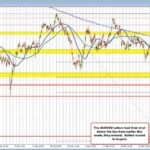
AUD/USD Exchange Rate Rebounds: Key Insights and Future Outlook
Tháng 4 9, 2025February 2025: U.S. Wholesale Sales Soar 2.4% – A Bright Spot for Economic Recovery
Tháng 4 9, 2025U.S. Wholesale Sales Surge in February 2025: Analyzing Key Economic Indicators
Recent statistics reveal a compelling development in the U.S. economy, particularly in wholesale sales. In February 2025, wholesale sales witnessed a remarkable increase of 2.4%, showcasing a rebound following a 1.3% decrease in the previous month. This uptick not only surpasses the anticipated gain of 0.8% but also signals a revitalization in wholesale trade activity, underscoring optimism among businesses and investors alike.
The Implications of Wholesale Sales Growth
The uptrend in wholesale sales is significant for several reasons. First, it illustrates a recovery in consumer demand and business investment, which often correlate with increased economic productivity. When wholesalers report stronger sales, it can indicate that retailers are replenishing their inventories in anticipation of increased consumer spending. This boost can also lead to a ripple effect throughout the supply chain, prompting manufacturers to ramp up production, potentially leading to job creation and economic expansion. The importance of understanding such dynamics can be highlighted in discussions of investment mistakes to avoid, particularly those related to shifts in wholesale sales (source).
In conjunction with the increase in sales, U.S. wholesale inventories rose by 0.3% in February, bringing total inventories to an impressive $902.3 billion. The relationship between sales and inventory levels is crucial in this context; when inventory growth lags behind sales increases, manufacturers are compelled to enhance production to meet rising demand. This dynamic could pave the way for sustained economic growth if consumer confidence remains strong. For those looking to further understand investment strategies in this context, exploring the insights from value investing can provide a long-term perspective that proves beneficial amid market fluctuations (source).
Broader Economic Context: Trade Deficits and Industry Impact
While the increase in wholesale sales and inventory levels paint a positive picture, it is essential to consider the broader economic backdrop. In February, the U.S. goods and services trade deficit contracted to $122.7 billion, down from $130.7 billion in January. This shift is primarily attributed to a decline in the goods deficit despite a marginal decrease in the services surplus. The trade deficit is a vital economic indicator, and its reduction can have profound implications for currency valuation, inflation rates, and overall economic health.
When the trade deficit shrinks, it may suggest that domestic manufacturers are becoming more competitive and that there is potentially less reliance on imported goods. This positive shift, paired with robust wholesale sales, could fuel economic optimism, fostering a more stable environment for businesses to invest and expand. Investors should remain aware of common pitfalls that can arise during such periods of adjustment and how these can impact their decision-making (source).
Conclusion: A Positive Trend Amidst Trade Challenges
In summary, the recent surge in U.S. wholesale sales signals a beneficial trend within the economy, defying earlier pessimism and hinting at robust industrial activity. The accompanying rise in wholesale inventories further indicates that businesses are preparing for an upturn in demand, setting the stage for potential economic expansion. However, the ongoing trade deficit remains a critical factor that stakeholders must monitor. As wholesalers and manufacturers navigate this complex economic landscape, the interaction between consumer demand, inventory levels, and trade dynamics will be crucial in shaping the trajectory of the U.S. economy moving forward.
